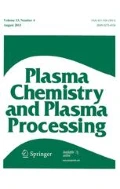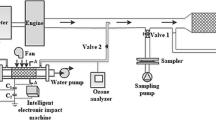Abstract
Experimentation was conducted to analyze the diesel particulate filters (DPF) trap under four different engine loads with particle size analysis and thermo-gravimetric analysis introduced to characterize particulate matter (PM) samples. DPF regeneration was achieved utilizing an oxygen-fed non-thermal plasma (NTP) injection system. Results indicated that accompanying the increase of engine load, the concentration of nucleation mode particles decrease while that of accumulation mode particles and the total concentration number increase at first and then decrease with the total concentration number of PM peaking at 50% load. H2O and soluable organic fraction in PM demonstrate a downward trend while dry soot exhibits an upward trend in mass fraction with the increasing load. NTP may then separate PM into CO and CO2. Size distribution and ingredients of PM trapped by DPF under different loads vary, thus the intensity of reaction between PM and radical gases produced by NTP is different. C1 (C in CO) exhibited a declining trend with the increasing of engine load, while C2 (C in CO2) and C12 (sum of C1 and C2) increase first and decrease after. Mass of PM removal maximizes at 50% load while DPF regeneration effect is the most remarkable.










Similar content being viewed by others
References
Correa MS, Arbilla G (2008) Carbonyl emissions in diesel and biodiesel exhaust. Atmos Environ 42(2):769–775
Wang CC, Chen RJ, Zhao ZH, Cai J, Lu JX, Ha SD, Xu XH, Chen X, Kan HD (2015) Particulate air pollution and circulating biomarkers among type 2 diabetic mellitus patients: the roles of particle size and time windows of exposure. Environ Res 140:112–118
Topinka J, Milcova A, Schmuczerova J, Krouzek J, Hovorka J (2013) Ultrafine particles are not major carriers of carcinogenic PAHs and their genotoxicity in size-segregated aerosols. Mutat Res/Genet Toxicol Environ Mutagen 754(1–2):1–6
Wang CM, Xu HM, Herreros MJ, Wang JX, Cracknell R (2014) Impact of fuel and injection system on particle emissions from a GDI engine. Appl Energy 132:178–191
Tan PQ, Ruan SS, Hu ZY, Lou DM, Li H (2014) Particle number emissions from a light-duty diesel engine with biodiesel fuels under transient-state operating conditions. Appl Energy 113:22–31
Walter K (2008) Diesel engine development in view of reduced emission standards. Energy 33:264–271
Martyn VT (2007) Progress and future challenges in controlling automotive exhaust gas emissions. Appl Catal B 70(1–4):2–15
Meng ZW, Guo D, Song QY, Yao Q, Xu XC (2008) Experimental investigation on the influence of wall-flow diesel particulate filter parameters on filter performance. J Eng Thermophys 29(1):171–173
Zhang H, Wang WL, Yang JJ, Wang JQ (2010) After-treatment technology for vehicle diesel. China Science and Technology Press, Beijing
Chen P, Ibrahim U, Wang J (2014) Experimental investigation of diesel and biodiesel post injections during active diesel particulate filter regenerations. Fuel 130(7):286–295
Chen K, Martirosyan KS, Luss D (2010) Temperature excursions during soot combustion in a diesel particulate filter (DPF). Ind Eng Chem Res 49:10358–10363
Palma V, Ciambellia P, Melonia E, Sin A (2015) Catalytic DPF microwave assisted active regeneration. Fuel 140:50–61
Palma V, Ciambellia P, Melonia E, Sin A (2013) Study of the catalyst load for a microwave susceptible catalytic DPF. Catal Today 216:185–193
Beatrice C, Iorio SD, Guido C, Napolitano P (2012) Detailed characterization of particulate emissions of an automotive catalyzed DPF using actual regeneration strategies. Exp Thermal Fluid Sci 39:45–53
Perez VR, Lopez AB (2015) Catalytic regeneration of diesel particulate filters: comparison of Pt and CePr active phases. Chem Eng J 279:79–85
Kuroki T, Fujishima H, Otsuka K, Ito T, Okubo M, Yamamoto T, Yoshida K (2008) Continuous operation of commercial-scale plasma–chemical aftertreatment system of smoke tube boiler emission with oxidation reduction potential and pH control. Thin Solid Films 516(19):6704–6709
Kuwahara T, Kuroki T, Yoshida K, Saeki N, Okubo M (2012) Development of sterilization device using air nonthermal plasma jet induced by atmospheric pressure corona discharge. Thin Solid Films 523:2–5
Kameda T, Inazu K, Hisamatsu Y, Bandow H (2006) Isomer distribution of nitrotriphenylenes in airborne particles, diesel exhaust particles, and the productsof gas-phase radical-initiated nitration of triphenylene. Atmos Environ 40(40):7742–7751
Kirkpatrick MJ, Odic E, Zinola S, Lavy J (2012) Plasma assisted heterogeneous catalytic oxidation: HCCI Diesel engine investigations. Appl Catal B 117–118:1–9
Chen YY, Cai YX, Li XH, SHI YX, Zheng Y (2015) Experimental study on regenerating fouled EGR cooler by NTPI technology. Int J Automot Technol 16(2):183–191
Fan YS, Cai YX, Li XH, Yin HY, Chen L, Liu S (2015) Regeneration of the HZSM-5 zeolite deactivated in the upgrading of bio-oil via non-thermal plasma injection (NTPI) technology. J Anal Appl Pyrol 111:209–215
Thomas SE, Martin AR, Raybone D, Shawcross JT, Ng KL, Beech P (2000) Non thermal plasma aftertreatment of particulates-theoretical limits and impact on reactor design. SAE Technical Paper No. 2000-01-1926
Fushimi C, Madokoro K, Yao S, Fujioka Y, Yamada K (2008) Influence of polarity and rise time of pulse voltage waveforms on diesel particulate matter removal using an uneven dielectric barrier discharge reactor. Plasma Chem Plasma Process 28:511–522
Babaie M, Davari P, Talebizadeh P, Zare F, Rahimzadeh H, Ristovski Z, Brown R (2015) Performance evaluation of non-thermal plasma on particulate matter, ozone and CO2 correlation for diesel exhaust emission reduction. Chem Eng J 276:240–248
Okubo M, Kuroki T, Yamamoto T, Miwa S (2003) Soot incineration of diesel particulate filter using honeycomb nonthermal plasma. SAE Paper No. 2003-01-1886
Okubo M, Kuroki T, Miyairi Y, Yamamoto T (2004) Low-temperature soot incineration of diesel particulate filter using remote nonthermal plasma induced by a pulsed barrier discharge. IEEE Trans Ind Appl 40(6):1504–1512
Okubo M, Arita N, Kuroki T, Yamamoto T (2007) Carbon particulate matter incineration in diesel engine emissions using indirect nonthermal plasma processing. Thin Solid Films 515(9):4289–4295
Okubo M, Arita N, Kuroki T, Yoshida K, Yamamoto T (2008) Total diesel emission control technology using ozone injection and plasma desorption. Plasma Chem Plasma Process 28(2):173–187
Okubo M, Kuwahara T, Kanaka Y, Kuroki T (2010) Improvement of NOx reduction efficiency in diesel emission using nonthermal plasma-exhaust gas recirculation combined aftertreatment. IEEE Ind Appl Soc Annu Meet, pp 1–7
Shi YX, Cai YX, Li XH, Chen YY, Ding DW, Tang W (2014) Mechanism and method of DPF regeneration by oxygen radical generated by NTP technology. Int J Automot Technol 15(6):871–876
Shi YX, Cai YX, Li KH, Li XH, Chen YY (2013) Experiment study on the DPF regeneration based on non-thermal plasma technology. Appl Mech Mater 327:1347–1351
Shi YX, Cai YX, Li XH, Xu H, Li WJ, Pu XY (2016) Low temperature dpf regeneration by non-thermal plasma injection system with air source. Plasma Chem Plasma Process 36(3):783–797
Koudriavtsev O, Wang S, Konishi Y, Nakaoka M (2002) A novel pulse-density-modulated high-frequency inverter for silent-dischargetype ozonizer. IEEE Trans Ind Appl 38(2):369–378
Kittelson DB (1998) Enginges and nanoparticles: a review. Aerosol Sci 29(5/6):575–588
Schneider J, Hock N, Weimer S, Borrmann S, Kirchner U, Vogt R (2005) Nucleation particles in diesel exhaust: composition inferred from in situ mass spectrometric analysis. Environ Sci Technol 39(16):6153–6161
Kwak JH, Kim HS, Lee JH, Lee SH (2014) On-road chasing measurement of exhaust particle emissions from diesel, CNG, LPG and DME-Fueled vehicles using a mobile emission laboratory. Int J Automot Technol 15(4):543–551
Tartakovsky L, Baibikov V, Comte P, Czerwinski J, Mayer A, Veinblat M, Zimmerli Y (2015) Ultrafine particle emissions by in-use diesel buses of variousgenerations at low-load regimes. Atmos Environ 107:273–280
Acknowledgements
The authors gratefully acknowledge the support provided by the National Natural Science Foundation of China (51676089), the Major Program of Natural Science Foundation of Jiangsu Province (16KJA470002), the Priority Academic Program Development of Jiangsu Higher Education Institutions ([2011]No.6) and the Graduate Students Scientific Research Innovation Project of Jiangsu Ordinary University (KYLX15_1070).
Author information
Authors and Affiliations
Corresponding author
Rights and permissions
About this article
Cite this article
Shi, Y., Cai, Y., Wang, J. et al. Influence of PM Size Distribution and Ingredients on DPF Regeneration by Non-thermal Plasma Technology. Plasma Chem Plasma Process 37, 451–464 (2017). https://doi.org/10.1007/s11090-016-9775-5
Received:
Accepted:
Published:
Issue Date:
DOI: https://doi.org/10.1007/s11090-016-9775-5




